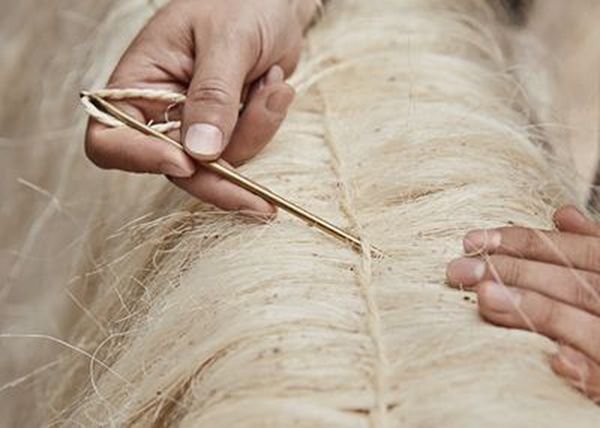
Fernando Laposse: a grain of truth
Fernando Laposse’s CV might broadly describe him as a designer, but scratch beneath the surface and his wide-ranging creations encompass a breadth of disciplines.
Words Jim Butler
Photography Jake Curtis
Video filming Sasha Bajac
Video editing Marie-Cecile Embleton

Art, gastronomy, science, politics, geography, history, economics, alchemy, entrepreneurialism, mixology and activism can all be found in his labours. At the heart of his work is a fascination with food – its production, how it’s embedded in notions of global economics, and the way it reflects and shapes national identity. As a 30-year-old Mexican, he has finally come to focus his work on his homeland’s vexed relationship with its most important crop – corn. Hence, his itinerant way of life.
‘I’m following the cycle of corn,’ he explains from his London studio. ‘I’ll be in Mexico to plant. I’ll come back to London to design and produce, and then I’ll go back to Mexico for harvest.’ This is a process that underpins his award-winning ‘Totomoxtle’ project – a series of products made from the transformed raw materials of endangered native Mexican corn. To date, he’s made everything from tables and cabinets to lamps and vases. ‘Totomoxtle’ goes beyond aesthetics though. It talks to us about the destruction of Mexico’s traditional farmland and the erosion of native corn in the face of an industrial hybrid.
For Laposse, design is a point of entry to ideas that might seem more complex. ‘It can simplify things that might seem boring and complicated,’ he told me last year when we first spoke. ‘It has the power of simplifying things and creating an object that is representative of all these ideas.’
A year on and Totomoxtle has taken further strides. Towards the end of last year, Laposse won the inaugural Future Food Design competition during Dutch Design Week.

‘When people ask for a definition of food design, the truth of the matter is that most people don’t really know. My vision is based upon remaining a designer.’

Scooping first prize meant he secured funding to push the project on. Not only could he buy more equipment that enabled the residents of Tonahuixtla (the Mexican village where his project is based) to manufacture the husks of corn, it meant he could spend more time, quite literally, in the field.
‘I’m at a point now where I’m organising proper production,’ he says. ‘So alongside the equipment we bought, we spent a couple of months training people. Previously I was still manufacturing the material myself. The plan was always to get people to do it over there.’ Another recent installation, at the London Design Festival, involved ‘sisal’, a sustainable fibre made from the agave plant – once a mainstay of Mexican manufacturing. In ‘Sisal Sanctum’, Laposse used the fibre to create giant sculptures, and start a conversation on why this hardy material was replaced by plastic.
Laposse is a graduate of London’s Central Saint Martins art school, and began by creating ‘glass’ that you could eat (it was actually sugar).And while he admits there’s a huge amount of food design to what he does, he’s careful not to lurch too far into what he describes as ‘catering’. ‘I think that’s the trap with a lot of food designers,’ he says. ‘When people ask for a definition of food design, the truth of the matter is that most people don’t really know. My vision is based upon remaining a designer.’ His design skills, both aesthetic and functional, are at the heart of Totomoxtle. Here, he takes the husks from Mexico’s rich native corn (there are over 60 varieties) and transforms them into a veneering material that can be used for making marquetry, interior furniture and wall panels. One of the central aims is to encourage farmers to plant native corn again.
And here, Laposse’s collaboration with the International Maize and Wheat Improvement Center (better known by its Spanish acronym, CIMMYT) has also been beneficial. Denise Costich, CIMMYT’s Head of the Maize Collection, contacted Laposse with a view to using some of the traditional seeds it holds in its vast seed bank.

As well as giving Laposse access to seeds that were ‘technically extinct’ (vital because seed banks need to refresh their stock every so often to keep them viable) it furthered his knowledge of, and his appreciation for, the crop that without which – according to a national proverb – there is no Mexico. So does he sense that when people buy his pieces they’re engaging fully with the political and economic implications of the objects? He isn’t so sure.
‘I just had an experience where people just wanted to talk about the material, whether they could make a floor with it,’ he says. ‘But one collector who purchased a table was interested in the story behind it. Totomoxtle is stretching out to become a communication project. If I can convey this idea that’s great.’
For Laposse the primary aim of Totomoxtle is biodiversity. He refers to a recent National Geographic article that states that between 1903 and 1983 the US lost 93 per cent of its unique seed strands. What has happened in the tiny village of Tonahuixtla is just a microcosm of what is happening globally. ‘It’s outrageous,’ he says. ‘Look in supermarkets and they stock about 12 different vegetables. That’s it. If we depend on such a small variety of food plants we could become exposed to a major plague – or we’re at the mercy of climate change.’ Laposse says this is fundamentally about how we want to feed ourselves.
‘The fewer varieties we have the more additives we need to put into those we are planting,’ he says. ‘More varieties mean more security, but it also means healthier products in general.’In the hands of Fernando Laposse, design is much more than a table, a lamp or some tiles.


